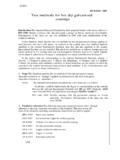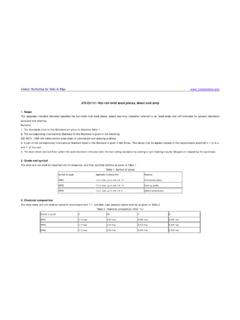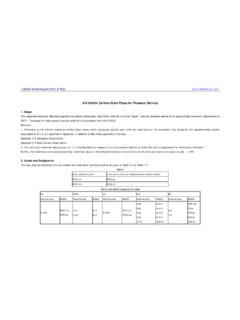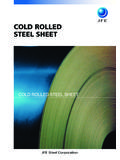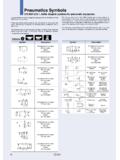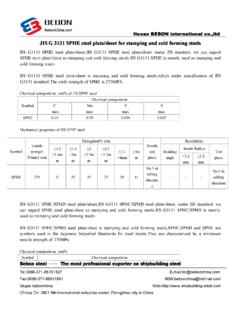Transcription of Antimicrobial products-Test for antimicrobial …
1 JIS. japanese . industrial . STANDARD. Translated and Published by japanese standards Association JIS Z 2801 :2000. Antimicrobial products-Test for Antimicrobial activity and efficacy ICS ; Descriptors : bacteriocide- activity determination, microbiological-resistance tests , biological hazards, culture techniques Reference number : JIS Z 2801: 2000 (E). 8S. japanese industrial STANDARD JIS Z 2801: 2000. Antimicrobial products . Test for Antimicrobial activity and efficacy Introduction This japanese industrial Standard has been prepared for standardizing the method for evaluating Antimicrobial efficacy in Antimicrobial products shown in the report of the Meeting on Life-Related Processed Products with New Functions ( Antimicrobial Products): December 1998 (so-called "Guidelines for Antimicrobial Products").
2 This standard specifies the Antimicrobial efficacy, a part of the perfor- mance considered to be important for Antimicrobial products, and the testing methods. Other information considered to be important for Antimicrobial products including safety, duration of Antimicrobial efficacy, and marking on the product shall be referred to in the "Guidelines for Antimicrobial Products". 1 Scope This Standard specifies the testing methods to evaluate Antimicrobial activity and Antimicrobial efficacy on bacteria on the surface of Antimicrobial products (including intermediate products).
3 Remarks : The secondary effects of Antimicrobial efficacy, such as being anti- fungal and deodorizing efficacy, shall not be included in this Stan- dard. 2 Normative references The following standards contain provisions which, through reference in this Standard, constitute provisions of this Standard. The most recent editions of the standards indicated below (including amendments) shall be applied. JIS K 0950 Sterilized plastic petri dishes JIS K 0970 Piston operated micro-volumetric apparatus JIS K 3800 Class II biological safety cabinets JIS K 8101 Ethanol ( ).
4 JIS K 8150 Sodium chloride JIS K 8180 Hydrochloric acid JIS K 8263 Agar JIS K 8576 Sodium hydroxide JIS K 9007 Potassium dihydrogenphosphate JIS K 9017 Dipotassium hydrogenphosphate JIS L 1902 Testing method for antibacterial of textiles JIS R 3505 Volumetric glassware 3 Definitions The definitions of the main terms used in this Standard are as follows: a) Antimicrobial The condition inhibiting the growth of bacteria on the surface of products. Z 2801:2000. b) Antimicrobial finish A finishing treatment for Antimicrobial efficacy.
5 C) Antimicrobial products Products treated with Antimicrobial finish. d) value of Antimicrobial activity This value shows the difference in the loga- rithmic value of viable cell counts between Antimicrobial products and untreated products after inoculation and incubation of bacteria. Informative reference : The value of bacteriostatic activity in JIS L 1902 ex- presses that of the Antimicrobial activity in this Stan- dard. e) Antimicrobial efficacy The efficacy of Antimicrobial products judged from the value of Antimicrobial activity .
6 4 Antimicrobial efficacy The value of Antimicrobial activity obtained by the testing methods of this Standard shall not be less than for the Antimicrobial efficacy of Antimicrobial products. Values of over may be applicable subject to the agreement between parties concerned with delivery. 5 Testing method Testing method for textile products The testing method for textile products shall be in accordance with 8 of JIS L 1902. Testing method for plastic products, etc. This testing method is applicable to products other than textile products, such as plastic products, metal products, and ceramic products.
7 Testing method may be used, however, for products judged to be suitable for using the testing method for textile products from the usage and form of the product . Bacteria to be used for the tests The species of bacteria to be used for the tests shall be as follows, and each bacteria shall be used for the test: a) Staphylococcus aureus b) Escherichia coli An example of the bacterial strain to be used for the tests is shown in Table 1. If the bacterial strain is contributed by other culture collection shown in Table 1, then it shall be obtained from member agencies of the World Federation of Culture Collection (WPCC) or the Japan Society of Culture Collection (JSCC) and the same strain as that shown in Table 1.
8 Table 1 Bacterial strain to be used for the tests Bacteria Strain number Institution of culture collection Staphylococcus aureus ATCC6538P American Type Culture Collection FDA209P Food and Drug Administration IFO12732 Institute for Fermentation Escherichia coli ATCC8739 American Type Culture Collection IFO3972 Institute for Fermentation Z 2801:2000. Chemicals, materials and apparatus The chemicals, materials and apparatus to be used in this Standard shall be given as follows, unless otherwise designated. Ethanol (C2H5OH) Class I as specified in JIS K 8102 or superior.
9 Beef extract For microbial tests . Peptone For microbial tests . Sodium chloride (NaCl). Guaranteed reagent specified in JIS K 8150. Purified water Conforms to the reference of the 13th revised japanese Phar- macopoeia. Agar Guaranteed or superior reagent specified in JIS K 8263. Yeast extract For microbial tests . For Tryptone microbial tests . For Glucose microbial tests . For Casein peptone microbial tests . For Soybean peptone microbial tests . For Lecithin microbial tests . Nonionic surfactant Polyoxyethylene sorbitan monooleate [Polysorbate 80 (Tween 80)].
10 Potassium dihydrogenphosphate (KH2PC4). Guaranteed reagent specified in JIS K 9007. Dipotassium hydrogenphosphate (K2 HPC4). Guaranteed reagent specified in JIS K 9017. Sodium hydroxide (NaOH). Guaranteed reagent specified in JIS K 8576. Hydrochloric acid (HC1). Guaranteed reagent specified in JIS E 8180. Cotton stopper, etc. OME cotton, otherwise silicone, metal, or morton stopper. Platinum loop With a loop of about 4 mm at the point. Dry-heat sterilizer Capable of keeping the temperature from 160 C to 180 C. Autoclave Capable of keeping at 121 C temperature and 103 kPa of pressure.
